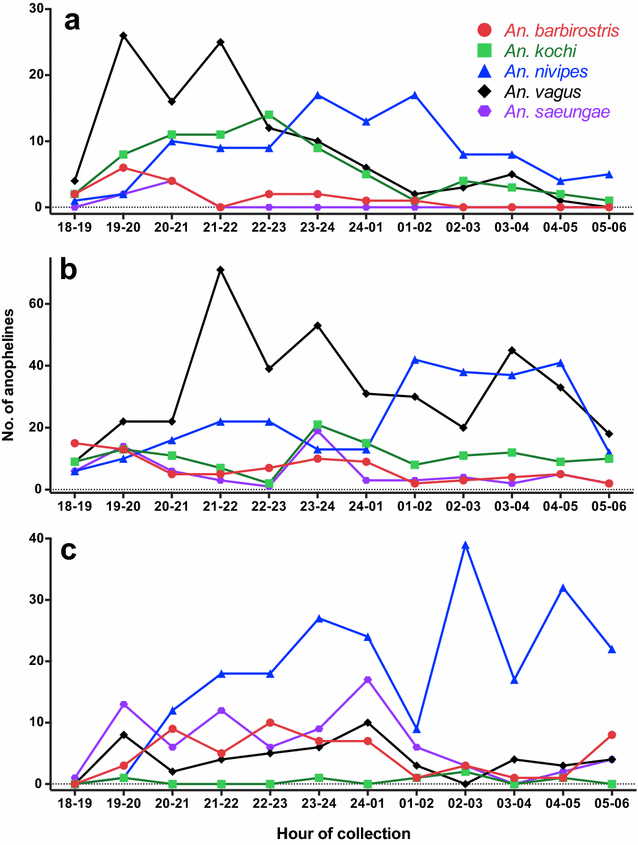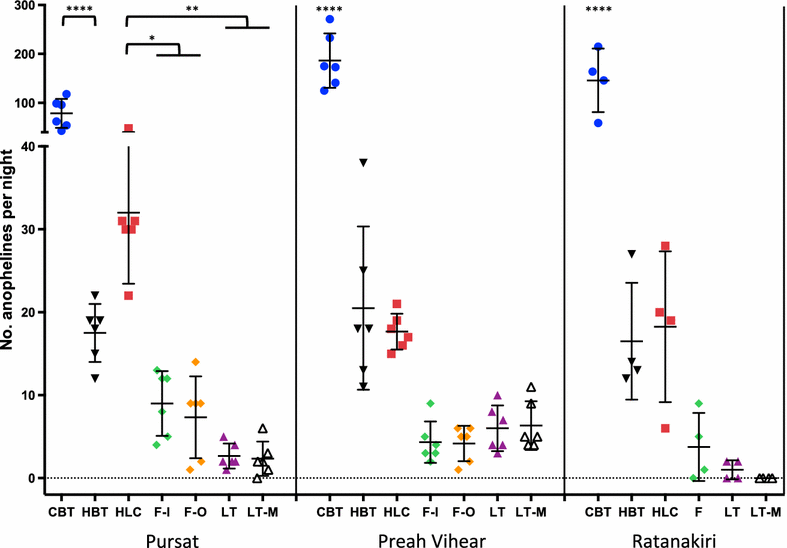Cow-baited tents are highly effective in sampling diverse Anopheles malaria vectors in Cambodia
- PMID: 27577697
- PMCID: PMC5004278
- DOI: 10.1186/s12936-016-1488-y
Cow-baited tents are highly effective in sampling diverse Anopheles malaria vectors in Cambodia
Abstract
Background: The accurate monitoring and evaluation of malaria vectors requires efficient sampling. The objective of this study was to compare methods for sampling outdoor-biting Anopheles mosquitoes in Cambodia.
Methods: In the Cambodian provinces of Pursat, Preah Vihear, and Ratanakiri, six different mosquito trapping methods were evaluated: human landing collection (HLC), human-baited tent (HBT), cow-baited tent (CBT), CDC miniature light trap (LT), CDC miniature light trap baited with molasses and yeast (LT-M), and barrier fence (F) in a Latin square design during four or six consecutive nights at the height of the malaria transmission season.
Results: Using all traps, a total of 507, 1175, and 615 anophelines were collected in Pursat, Preah Vihear, and Ratanakiri, respectively. CBTs captured 10- to 20-fold more anophelines per night than the other five sampling methods. All 2297 Anopheles mosquitoes were morphologically identified and molecularly typed using standard morphological keys and sequencing the rDNA ITS2 region to distinguish cryptic species, respectively. Overall, an extremely diverse set of 27 known Anopheles species was sampled. CBTs captured the same molecular species that HLCs and the other four traps did, as well as additional species. Nine specimens representing five Anopheles species (Anopheles hyrcanus, Anopheles barbirostris sensu stricto, Anopheles barbirostris clade III, Anopheles nivipes, and Anopheles peditaeniatus) were infected with Plasmodium falciparum and were exclusively captured in CBTs.
Conclusions: These data indicate that cow-baited tents are highly effective in sampling diverse Anopheles malaria vectors in Cambodia. This sampling method captured high numbers of anophelines with limited sampling effort and greatly reduced human exposure to mosquito bites compared to the gold-standard human landing collection.
Keywords: Anopheles; Cambodia; Malaria; Outdoor transmission; Trap; Vector.
Figures


References
-
- Sanh NH, Van Dung N, Thanh NX, Trung TN, Van Co T, Cooper RD. Forest malaria in central Vietnam. Am J Trop Med Hyg. 2008;79:652–654. - PubMed
Publication types
MeSH terms
Substances
LinkOut - more resources
Full Text Sources
Other Literature Sources

